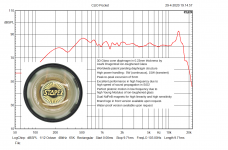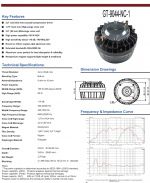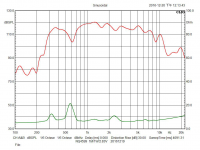Like an SB26ADC, for example. A typical hi-fi style dome tweeter. I mean, really, the only differences between a regular dome tweeter and a CD used on its backside are that the CD diaphragm is way bigger and it tends to be more rigid. Neither of them "come with" a phase plug.
I've done a fair bit of work with that, including with that very tweeter, and I kinda burned out on it, TBH (see here : DIY Compression Drivers)
my takeaways:
1) Almost every 3/4" tweeter works quite well on a waveguide with a 1" throat
2) Once the diameter exceeds 3/4", it gets REALLY hard. Basically I was constantly seeing issues between 10 and 20khz. TBH these issues might not even be audible, but the 3/4" tweeters performed so much better, it was difficult to get motivated to keep building waveguides for 1" tweeters, only to see them crash and burn. In my measurements, the 1" tweeter from Tymphany was about 2dB louder than the 3/4" tweeter from Tymphany. (This is a neat case, because it's one of the rare tweeters where you can buy two that are literally identical, just 'scaled up.'
If you invest some time with Axidriver, you'll quickly see that it's exceptionally difficult to get the 1" tweeters to work. Again, not saying IMPOSSIBLE but Lordy is that a lot of work for what amounts to about an additional 2dB of output.
The last part of the equation, which was particularly discouraging, is that the behavior of the diaphragm appears to be *very* important. IE, the software treats the diaphragm as if it's perfect, but in the real world, it's not. This was one of the reasons I prefer silk domes on waveguides to aluminum domes on waveguides; silk is better behaved.
When everything is said and done, the Eminence N151M is just so stupid-good and stupid cheap, it really left me wondering what the point of messing around with dome tweeters is.
I started messing with dome tweeters largely because I didn't want to publish anything that could be cloned in China. IE, I decided that if I was going to sell Unity horn waveguides, I'd 'cripple' them by NOT using a compression driver. On top of that, nobody is going to need the output of a compression driver in their home, it's overkill.
But the compression drivers are just so much better behaved, I just reached a point where my attitude was basically "yes this is utter overkill for a living room, but I also value my time and dome tweeters are a crapshoot on waveguides. Yes, they sometimes work, but the N151M works *reliably* and it's only $40 more than a dome."
I have no idea what's going on in the engineering departments of JBL and B&C and Eminence, but I have a hunch that they're probably doing much more advanced models than in the past, and we're seeing compression drivers that exceed what was possible in 2010 or 2000.
Again, looking at the N151M, it's better in every way, versus my compression drivers that I have here at the house:
1) It's way cheaper than BMS 4552
2) It's cheaper than JBL 2408H-1 *and* it's better built *and* it has wider bandwidth
3) It's cheaper than the Celestion CDX1-1425. The Celestion is probably it's closest match. The Celestion kinda bugs me because I am annoyed that they used a converging wavefront at the exit, that seems like a dumb decision to me. YMMV
4) It has wider bandwith than the B&C DE250 and it's clones, and it's much smaller / lighter.
Try this.
very interesting, but it can't even hit 95 db at 1 meter.... bateman would never be happy with that!
Appreciate the detailed response. All I can say to that is, now we have mabat to solve the problem for us. 🙂I've done a fair bit of work with that, including with that very tweeter, and I kinda burned out on it, TBH (see here : DIY Compression Drivers)
my takeaways:
1) Almost every 3/4" tweeter works quite well on a waveguide with a 1" throat
2) Once the diameter exceeds 3/4", it gets REALLY hard. Basically I was constantly seeing issues between 10 and 20khz. TBH these issues might not even be audible, but the 3/4" tweeters performed so much better, it was difficult to get motivated to keep building waveguides for 1" tweeters, only to see them crash and burn. In my measurements, the 1" tweeter from Tymphany was about 2dB louder than the 3/4" tweeter from Tymphany. (This is a neat case, because it's one of the rare tweeters where you can buy two that are literally identical, just 'scaled up.'
If you invest some time with Axidriver, you'll quickly see that it's exceptionally difficult to get the 1" tweeters to work. Again, not saying IMPOSSIBLE but Lordy is that a lot of work for what amounts to about an additional 2dB of output.
The last part of the equation, which was particularly discouraging, is that the behavior of the diaphragm appears to be *very* important. IE, the software treats the diaphragm as if it's perfect, but in the real world, it's not. This was one of the reasons I prefer silk domes on waveguides to aluminum domes on waveguides; silk is better behaved.
When everything is said and done, the Eminence N151M is just so stupid-good and stupid cheap, it really left me wondering what the point of messing around with dome tweeters is.
I started messing with dome tweeters largely because I didn't want to publish anything that could be cloned in China. IE, I decided that if I was going to sell Unity horn waveguides, I'd 'cripple' them by NOT using a compression driver. On top of that, nobody is going to need the output of a compression driver in their home, it's overkill.
But the compression drivers are just so much better behaved, I just reached a point where my attitude was basically "yes this is utter overkill for a living room, but I also value my time and dome tweeters are a crapshoot on waveguides. Yes, they sometimes work, but the N151M works *reliably* and it's only $40 more than a dome."
I have no idea what's going on in the engineering departments of JBL and B&C and Eminence, but I have a hunch that they're probably doing much more advanced models than in the past, and we're seeing compression drivers that exceed what was possible in 2010 or 2000.
Again, looking at the N151M, it's better in every way, versus my compression drivers that I have here at the house:
1) It's way cheaper than BMS 4552
2) It's cheaper than JBL 2408H-1 *and* it's better built *and* it has wider bandwidth
3) It's cheaper than the Celestion CDX1-1425. The Celestion is probably it's closest match. The Celestion kinda bugs me because I am annoyed that they used a converging wavefront at the exit, that seems like a dumb decision to me. YMMV
4) It has wider bandwith than the B&C DE250 and it's clones, and it's much smaller / lighter.
Guys, I want something that can be crossed over at 500 - 700 Hz in a big waveguide at the same time. These small tweeters are of no use to me 🙂
The viable option, at least as I see it, would be to blend the phase plug with the waveguide, right from the start. It still seems unnecessary to me going for a flat wavefront and then diffracting it to spherical, if the spherical is actually the target. This is my whole reasoning at the moment.
The viable option, at least as I see it, would be to blend the phase plug with the waveguide, right from the start. It still seems unnecessary to me going for a flat wavefront and then diffracting it to spherical, if the spherical is actually the target. This is my whole reasoning at the moment.
Mabat, have you thought about the b&c dcx464?
It costs like a kidney, but it seems to be a nice driver for the intended use (it can go as low as 300hz).
It costs like a kidney, but it seems to be a nice driver for the intended use (it can go as low as 300hz).
Yes I have, and was pretty excited about it at first. But from what I've seen it didn't quite convince me, costing what it does. I don't need 300 Hz as 600 Hz is fine, and if you look at the high frequency response, there are still problems I would like to avoid. The midrange response is terrific though.
That of course depends on the target output levels and what you mean by "reasonable". As was shown, you don't have to keep the coverage of the waveguide controlled down to that extremely low frequencies, but anyway, even the DCX464 would be pushed rather hard that low I think. No own experience here.
There are no frequency response data there but if specified at 200 - 9k, I'm afraid it would require one more driver above that for high frequencies and that would be a big NO GO for me.
Question is can you sim arbitrary driver to get 200Hz with 70cm diameter. Efficiency can be below 100dB because most will do passive anyway.
Is 200Hz possible with reasonable size?
Test Bench: B&C Speakers DCX464 High Power Coaxial Compression Driver and Horn | audioXpress
To me it looks like, given the right horn, It can be used down to 200hz. But I wouldn't go that low.
I don't understand what's the unknown as any decent waveguide will be smooth there, as will be the driver since it is acoustically small that low.
mabat, seen the Berstis lens? might give some ideas for your venture?🙂 Berstis Lens
Math as code, paper and STL file The Berstis Web Page
Math as code, paper and STL file The Berstis Web Page
That's still the same old principle - you first put an effort in creating a flat wavefront, which you then, by even a bigger effort, somehow transform to spherical. Why not to create the spherical wave as soon as possible? I'm really looking forward to the first actual BEM experiments to see what I am missing.
I would understand that the flat wave output can be made smaller in size (with a concave dome). I only still don't see exactly why it would bring necessarily an advantage.
I would understand that the flat wave output can be made smaller in size (with a concave dome). I only still don't see exactly why it would bring necessarily an advantage.
Last edited:
- Home
- Loudspeakers
- Multi-Way
- Acoustic Horn Design – The Easy Way (Ath4)


